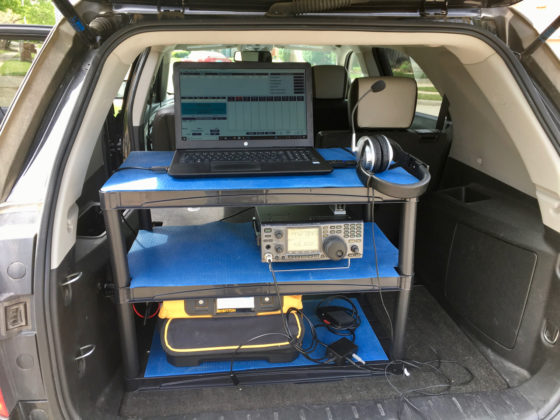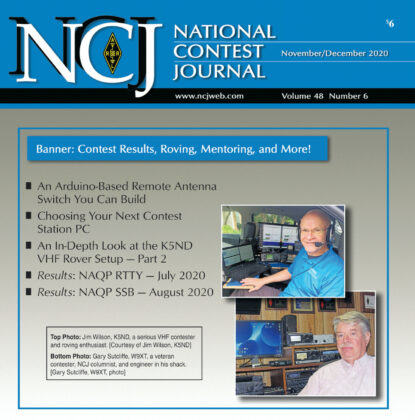K5ND/R Operations
My K5ND VHF Rover operations began by activating a few nearby grids and vacation grids for satellite operations. These can happen at any time of the year, and the satellite community is always delighted to receive a new grid.
Then, I moved on to some VHF contests and some rare grid FFMA rover operations.
Satellite Grids
I activated a few grids on satellites, all on FO-29 and SO-50. I used an IC-910H with a MacBook Air laptop and MacDoppler. I recorded audio on the laptop using the NoteBook app. I activated EN62 and EN63 on vacation in Michigan and EM23, EM22, EM11, EM03, and EM02 near my home base of EM12. I also activated the EM74 and EM84 gridline in eastern New Mexico along with EM28 and EN00.
All that, coupled with an article on my eastern New Mexico grid activation published in the AMSAT Journal, earned the AMSAT Rover Award. You can learn more about the award at AMSAT Rover Award.
When I roved in Kansas (EM28) and Nebraska (EN00), my grandkids Bennett and Avery got on the air. Here’s a wonderful video my XYL, Karen, made of Avery’s excitement when KB6LTY came back to her CQ on CAS-4B.
VHF-UHF Contests
My first contest rover operation was the ARRL September 2017 VHF Contest. I activated 8 grids around the Dallas – Fort Worth Area. But interestingly enough most of my contacts were south of DFW including Austin. I managed to come in 3rd in the Midwest Region and 1st in the West Gulf Division, limited rover.
In the ARRL January 2018 VHF Contest, I again entered as limited rover and activated 7 grids around the DFW area. I finished 5th in the West Gulf Division, limited rover. Both September and January were 2 m and 70 cm only since 6 m sporadic E wasn’t happening in those months.
For the ARRL June 2018 VHF contest, I updated my mast from a painter pole to fiberglass and put it to the test in the 2018 144 MHz Spring Sprint. That mast holds my Diamond 10-element 2 m yagi and 10-element 70 cm yagi as well as a stressed moxon for six meters. I run an IC-9100. Lots of 6 meter sporadic E and FT8.
In July 2018 I entered the rover category for the CQ WW VHF Contest and thanks in large part to a very nice 6 meter opening on Sunday, finished 3rd in the USA.
For the January 2019 VHF Contest, I set up a rooftop rotator system and an inside operating position. This virtually eliminated the setup time in each grid and kept me out of the elements while operating.
With absences for the 2019 World Scout Jamboree along with a recovery cruise, I missed the 2019 July and September VHF contests. I worked all the 2020 contests and January and June 2021. I worked the CQ WW VHF 2021 as a fixed station on the DM85/DM86 grid line in the Texas Panhandle. For September 2021, I elected to operate from home to gain some perspective on what has become of operating VHF contests from the ham shack. I had fun. I ended my VHF contest roving after activating the Texas Panhandle during the ARRL VHF June 2022 Contest.
Here’s a summary of the development of my VHF-UHF contest rover operations:
| Rover Ops | Rig | Mast | Antennas |
|---|---|---|---|
| Phase I | IC-910H | Painter Pole | Diamond Yagis 2m 70cm |
| Phase II | IC-9100 | MK-4-HD Fiberglass | Diamond and DSE Yagi, Moxon |
| Phase III | IC-9100 | Roof Top Rotator | DSE Yagis and Moxon |
My rover operation was part of an article on VHF Roving in the May 2019 QST. I’ve also written about my rover experiences for the ARRL’s National Contest Journal. Here are links to PDFs of the articles: January/February 2020, May/June 2020, and November/December 2020 issues.
Here are the results of my VHF contesting rover activities:
| Contest | Grids | Points | Results |
|---|---|---|---|
| 2017 September VHF - Limited Rover | 8 | 2,652 | 1st West Gulf |
| 2018 January VHF - Limited Rover | 7 | 3,538 | 5th West Gulf |
| 2018 June VHF - Limited Rover | 7 | 10,695 | 3rd West Gulf |
| 2018 CQ WW VHF - Rover | 4 | 19,822 | 3rd USA |
| 2018 September VHF - Limited Rover | 7 | 6,240 | 4th West Gulf |
| 2019 January VHF - Limited Rover | 10 | 8,820 | 3rd USA |
| 2019 June VHF - Limited Rover | 8 | 11,109 | 3rd West Gulf |
| 2020 January VHF - Limited Rover | 11 | 6,750 | 6th USA |
| 2020 June VHF - Limited Rover | 10 | 40,736 | 5th USA |
| 2020 CQ WW VHF - Rover | 2 | 10,990 | 12th USA |
| 2020 September VHF - Limited Rover | 10 | 7,452 | 6th USA |
| 2021 January VHF - Limited Rover | 11 | 14,514 | 4th USA |
| 2021 June VHF - Limited Rover | 8 | 25,877 | 5th USA |
| 2022 June VHF - Limited Rover | 2 | 20,988 | 10th USA |
At that point, my energy ran out from driving several hundred miles over a contest.
Here’s a quick video overview of my June 2020 contest run.
6 Meter Rare Grid Roving
In 2021 I provided a 6-meter rare grid activation. This effort supports those working toward the Fred Fish Memorial Award (FFMA). My first dedicated effort was before the CQ WW VHF Contest, where I activated the DM86/DM85 grid line in the Texas Panhandle.
The 6-meter rare grid activations mean using more power, in my case about 300 watts, a bigger antenna, 5-element Yagi, and a small generator for electrical power. It also means staying in place for the day. I will also note that my daughter has a home in DM85 north of Amarillo. Before the June 2022 VHF contest, I activated DM85 and DM84 with good results. But that was a very tiring effort.
In May 2024, I activated DM85 from my daughter’s ranch in the Texas Panhandle. Here’s the article Texas Panhandler — DM85 on 6 Meters. I followed that up in July 2025, see VHF Texas Panhandler Once More in DM85
Here are some photos from my VHF rover operations over the years.



















